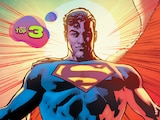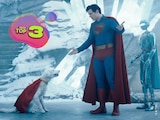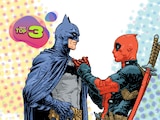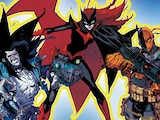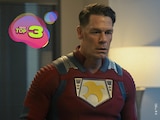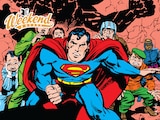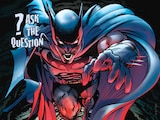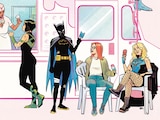You keep asking, and I keep answering…114 times and counting. Hello, I’m Alex Jaffe, known to the DC Community since 2018 as HubCityQuestion. Every month—almost every day, in fact—I make it my mission to come to you with solutions to the greatest DC problems your minds can conjure. Directories, histories and mysteries abound anew in each installment of this column I call ASK… THE QUESTION, and this month is no different. Let’s see what I have for you all this time around.
SILVER FOR FIRST

Rex Rebel asks:
DC’s Silver Age saw the reintroduction of many Golden Age heroes, like the Flash and Green Lantern, but who was the first brand new hero/villain of the Silver Age? Set whatever parameters you feel are appropriate for answering.
As I’ve covered in the past, defining exactly when the “Silver Age” began is something that varies from title to title, as each caught up with the zeitgeist at its own pace. But the most agreed upon starting point is July 1956’s Showcase #4, featuring the debut of Barry Allen.
The first villain in that issue, Turtle Man, is also a legacy character, inspired by Jay Garrick villain the Turtle. But the backup story, “The Man Who Broke the Time Barrier,” featured a super-thief from the distant future named Mazdan. Not only does time travel already feature into The Flash by Barry’s very first issue, but it also gives us our very first original Silver Age villain. Not one to let an OG go unrecognized, Cary Bates would bring Mazdan back years later for a two-part story in 1977’s The Flash #254-255.
READING FRENZY

Chain_Twix asks:
What are some good must-read storylines with King Shark?
As arguably the breakout character of Suicide Squad: Kill the Justice League, I’m not surprised you’d like to know more about this half-god shark-man. Since his introduction as a Superboy villain in the ’90s, King Shark has sported a remarkably vast array of personalities, from the jolly nerd of the Harley Quinn animated series to the scheming underworld figure of Aquaman. For a representative sampling of all Nanaue has to offer, I’d drop the following reading list on the hook:
- Superboy (1994) #9, #13-15, #20, #32, #66-67
- Aquaman: Sword of Atlantis
- Secret Six (2008) #25-36
- Suicide Squad (2011) #1-30
- Aquaman (2016) #30-40
- Suicide Squad: King Shark
- Suicide Squad: Blaze
ALSO FEATURING…

OGSAMSON asks:
What were all the features in Detective Comics / Action Comics from 1938-1985?
Boy, you sure know how to pick ‘em. All right, let’s do this.
The last issue of Action Comics published in 1985 was Action Comics #577, and the last issue of Detective Comics in 1985 was #560. So, we’ve got quite a bit of ground to cover here.
Let’s start with Action, in order of introduction. For the completionists out there, there may be a few gag strips I omit from the chronology, typically used to fill half or quarter pages given mostly to advertisers, as well as early text inserts, which were always one-shot stories unrelated to any continuity, and reprints from older magazines once we get to the ‘70s.
Superman: Faster than a speeding bullet, et cetera.
Featured: Action Comics #1-577 and onward.
Chuck Dawson: Avenging cowboy.
Featured: Action Comics #1-22.
Zatara: Backwards-casting magician.
Featured: Action Comics #1-141.

Sticky-Mitt Stimson (And Friends): The first six issues of Action Comics all feature a comic criminal who is caught by the authorities and never seen again—including Elmer the Eel, Shifty Simpson, Bad Bill, Phil the Floater and Pilferin’ Peet.
Featured: Action Comics #1-6.
Marco Polo: 13th century explorer.
Featured: Action Comics #1-17.
Pep Morgan: All-star athlete.
Featured: Action Comics #1-41.
Scoop Scanlon: Ace reporter.
Featured: Action Comics #1-13.
Tex Thomson: World-traveling American adventurer. Adopts the moniker “Mister America” in Action Comics #33 and “Americommando” in issue #54.
Featured: Action Comics #1-74.

Inspector Donald and Bobby: Father-and-son detectives.
Featured: Action Comics #2-4.
Clip Carson: World-traveling mercenary.
Featured: Action Comics #14-36.
The Three Aces: Crimefighting former army pilots Whistler Will, Fog Fortune and Gunner Bill.
Featured: Action Comics #18-63.
The Black Pirate: 16th century seafaring privateer, Jon Valor.
Featured: Action Comics #23-42.
Congo Bill: American explorer of the African continent. With a 19-year run in Action Comics, Bill gains his trademark ability to swap bodies with a golden gorilla only in the waning years of the feature, with issue #248.
Featured: Action Comics #37-261.

Vigilante: Country western songwriter turned avenger, Greg Sanders. (Later, renamed Greg Saunders.)
Featured: Action Comics #42-198.
Hayfoot Henry: Quick-witted gadabout who spoke in rhyme.
Featured: Action Comics #116-123.
Cabbie Casey: Taxi driver. Think Space Cabbie, but not in space.
Featured: Action Comics #119-120.
Tommy Tomorrow: Spacefaring adventurer protecting life across the solar system.
Featured: Action Comics #127-251.
The Texas Rangers: Lawmen of a newly incorporated Lone Star State in 1835.
Featured: Action Comics #140.
Yankee Doodle Doughboy: Revolutionary soldier in Washington’s army.
Featured: Action Comics #143.

Supergirl: Superman’s Kryptonian cousin and “secret weapon.”
Featured: Action Comics #252-402.
The Legion of Super-Heroes: Superboy’s young allies from the 30th century.
Featured: Action Comics #377-392.
Metamorpho: Ramona Fradon and Bob Haney’s Element Man.
Featured: Action Comics #413-418.
Human Target: Assassination decoy for hire. Around this time, Action Comics became structured around a lead Superman story with a rotating backup feature.
Featured: Action Comics #419-432.
Green Arrow: Star City’s Emerald Archer. Also featuring Black Canary. Usually traded off with The Atom.
Featured: Action Comics #421-458.

The Atom: Shrinking super-scientist Ray Palmer. In the early Bronze Age, traded off with Green Arrow; later rotated backup space with Air Wave and Aquaman, with all three heroes occasionally appearing in each other’s features as guest stars.
Featured: Action Comics #425-454, #487, #489, #515-533.
Superman and Pals: The mid-1970s—and, more sparingly, the early 1980s—sometimes featured one-shot backup stories highlighting supporting members of the Superman cast, including Mr. Mxyzptlk, Perry White, Krypto, Steve Lombard, Morgan Edge, Lori Lemaris and Lex Luthor—later, Brainiac, Jimmy Olsen and Ambush Bug. In late 1975, Superman began regularly featuring in both Action Comics features, sometimes giving more room in the backup to Clark Kent—and increasingly frequently, the entire magazine would only feature one book-length story.
Featured: Action Comics #455-486, #544, #563, #565.
Air Wave: The other Hal Jordan, with microwave-based powers. Rotated and occasionally crossed over with The Atom and Aquaman.
Featured: Action Comics #488, #511-535.
Aquaman: King of the world. (If you round up.) Rotated and occasionally crossed over with The Atom and Air Wave.
Featured: Action Comics #517-540.
That covers Action Comics. We’ll look at Detective Comics in next month’s column. But before we wrap up, we have one more answer for you. And it’s a fun one!
UNTOLD LEGENDS OF THE BATMAN

Lincolnfan78 asks:
In the 1989 Batman movie, during the intro, what was the Bat symbol made out of?
I went deep into the cold case file for this one. Lincolnfan originally submitted this question back in October of 2020. Not having any insider information on the makings of the ‘89 Batman film myself, and with the passing of designer Anton Furst in 1991, I had written this one off as unsolvable. But earlier this month, I got the opportunity to speak with long-time Batman film franchise producer Michael Uslan and remembered Lincolnfan’s question. Moments later, Michael sent me this picture from the Batman ‘89 set:

That’s right. That cool, gothic Batman symbol the camera slowly pans over in the film’s opening credits might be filmed to look as if it were made of stone, but it’s really clever filmography over paint and canvas. Talk about movie magic!
That’s our time this month, but get at me on the message boards if you’ve got a mystery on your mind. Even if it takes me a year or four, you never know what might happen if you only ASK… THE QUESTION.
Alex Jaffe is the author of our monthly "Ask the Question" column and writes about TV, movies, comics and superhero history for DC.com. Follow him on Bluesky at @AlexJaffe and find him in the DC Community as HubCityQuestion.
NOTE: The views and opinions expressed in this feature are solely those of Alex Jaffe and do not necessarily reflect those of DC or Warner Bros. Discovery, nor should they be read as confirmation or denial of future DC plans.

